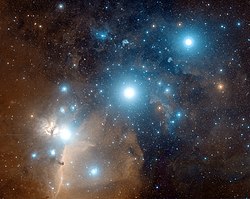Alnitak
|
Double star Alnitak (ζ Orionis) |
||||||||||||||||||||||||||
|---|---|---|---|---|---|---|---|---|---|---|---|---|---|---|---|---|---|---|---|---|---|---|---|---|---|---|
|
Observation dates equinox : J2000.0 , epoch : J2000.0 |
||||||||||||||||||||||||||
| AladinLite | ||||||||||||||||||||||||||
| Constellation | Orion | |||||||||||||||||||||||||
| Right ascension | 05 h 40 m 46 s | |||||||||||||||||||||||||
| declination | -01 ° 56.6 ′ | |||||||||||||||||||||||||
| Apparent brightness | 2.03 mag | |||||||||||||||||||||||||
| Astrometry | ||||||||||||||||||||||||||
| Radial velocity | 18.50 ± 1.30 / 13.0 km / s | |||||||||||||||||||||||||
| parallax | (3.99 ± 0.79) mas | |||||||||||||||||||||||||
| distance | approx. 800 ly (approx. 250 pc ) |
|||||||||||||||||||||||||
| Absolute bolometric magnitude M bol | approx. −4.95 mag | |||||||||||||||||||||||||
| Proper movement : | ||||||||||||||||||||||||||
| Rec. Share: | (3.99 ± 0.74) / ≈ +4 mas / a | |||||||||||||||||||||||||
| Dec. portion: | (2.54 ± 0.40) / ≈ −2 mas / a | |||||||||||||||||||||||||
| Individual data | ||||||||||||||||||||||||||
| Names | Aa, Ab; B. | |||||||||||||||||||||||||
| Observation data: | ||||||||||||||||||||||||||
| Apparent brightness | Aa, Ab | 2.05 mag | ||||||||||||||||||||||||
| B. | 4.21 likes | |||||||||||||||||||||||||
| Typing: | ||||||||||||||||||||||||||
| Spectral class | Aa, Ab | O9.7 Ib | ||||||||||||||||||||||||
| B. | B0 III | |||||||||||||||||||||||||
| B − V color index | Aa, Ab | −1.07 | ||||||||||||||||||||||||
| U − B color index | Aa, Ab | −0.21 | ||||||||||||||||||||||||
| Physical Properties: | ||||||||||||||||||||||||||
| radius | Aa, Ab | 10 R ☉ | ||||||||||||||||||||||||
| B. | ||||||||||||||||||||||||||
| Luminosity | Aa, Ab | 10,000 L ☉ | ||||||||||||||||||||||||
| B. | ||||||||||||||||||||||||||
| Effective temperature | Aa, Ab | 25,000 K | ||||||||||||||||||||||||
| B. | ||||||||||||||||||||||||||
| Other names and catalog entries |
||||||||||||||||||||||||||
|
||||||||||||||||||||||||||
| Triple system, consisting of Aa / Ab and B | ||||||||||||||||||||||||||
Alnitak (also Al Nitak ) is the name for the star ζ Orionis (Zeta Orionis), the left (eastern) belt star in Orion. The name ( Arabic النطاق, DMG an-niṭāq ) means “belt”, according to other sources “string of pearls”. Alnitak is a triple star and has an apparent magnitude of 2.03 mag.
In the immediate vicinity are the Horsehead Nebula and the Flame Nebula as parts of the Orion Nebula complex.
Main star
The main star Alnitak Aa belongs to the spectral class O9, its surface temperature is approx. 25,000 Kelvin . Like Beta , Delta and Epsilon Orionis , Zeta Orionis is also a bright blue supergiant with 100,000 times the bolometric luminosity of our sun . In the visual field, its luminosity is about 10,000 times greater than that of the sun. Alnitak is about 20 times the diameter of our sun. The distance from Alnitak is about 800 light years .
Two companions
Alnitak Aa has a close companion named Alnitak Ab who was only discovered in 2000. It is probably a main sequence star of the spectral class O with about 23 times the solar mass. The apparent brightness is around 4 mag and the luminosity in the visual area is accordingly about 1,300 times the solar luminosity.
At an angular distance of 2.3 ″ at a position angle of 165 degrees there is a more easily observable companion Alnitak B. Its brightness is 4.2 mag with about 1,100 times the visual solar luminosity, the spectral type is B0 III, the mass is about 13 solar masses estimated.
Alnitak was included in the third fundamental catalog FK3 (around 1950), but was no longer included in the FK4 as a double star visible in telescopes .
See also
Web links
Individual evidence
- ↑ a b Comp. A and Comp. B in "2nd Cat. Of Radial Velocities with Astrometric Data (Kharchenko +, 2007)"
- ↑ a b c d Bright Star Catalog (A) and Bright Star Catalog (B)
- ↑ a b Hipparcos catalog
- ↑ Remie and Lamers: Effective temperatures, and radii of luminous O and B stars - A test for the accuracy of the model atmospheres , A&A vol. 105, no. 1, Jan. 1982, p. 85-97.
- ^ Alnitak on the Solstation website


